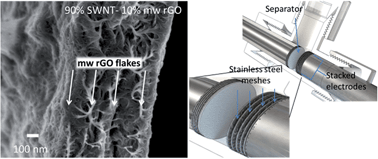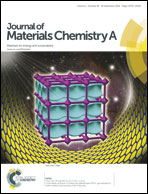Performance enhancement of single-walled nanotube–microwave exfoliated graphene oxide composite electrodes using a stacked electrode configuration†
Abstract
We report the development of a stacked electrode supercapacitor cell using stainless steel meshes as the current collectors and optimised single walled nanotubes (SWNT)–microwave exfoliated graphene oxide (mw rGO) composites as the electrode material. The introduction of mw rGO into a SWNT matrix creates an intertwined porous structure that enhances the electroactive surface area and capacitive performance due to the 3-D hierarchical structure that is formed. The composite structure was optimised by varying the weight ratio of the SWNTs and mw rGO. The best performing ratio was the 90% SWNT–10% mw rGO electrode which achieved a specific capacitance of 306 F g−1 (3 electrode measurement calculated at 20 mV s−1). The 90% SWNT–10% mw rGO was then fabricated into a stacked electrode configuration (SEC) which significantly enhanced the electrode performance per volume (1.43 mW h cm−3, & 6.25 W cm−3). Device testing showed excellent switching capability up to 10 A g−1, and very good stability over 10 000 cycles at 1.0 A g−1 with 93% capacity retention.


 Please wait while we load your content...
Please wait while we load your content...